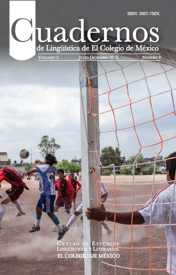The aspectual system of Acazulco Otomi
DOI:
https://doi.org/10.24201/clecm.v5i2.119Keywords:
Otomi, Otomanguean, aspect, morphology, inflection.Abstract
Some Otomi languages (Otomanguean, Otopamean) have been described as having tense and mood as primary TAM categories, while in others aspect and mood are treated as primary. The present paper describes the aspect categories of Acazulco Otomi (Ocoyoacac, Mexico State) as used in oral texts in an online corpus. By comparing paradigmatic, semantic, and morphological features in the categories of the TAM system, the paper shows that tense is a secondary category with respect to aspect. This paper also proposes a series of research lines that are relevant to the comparison of Otomi TAM systems, as well as to topics in language typology.Downloads
References
Andrews, Henrietta. 1993. The function of verb prefixes in Southwestern Otomi. Arlington: Instituto Lingüístico de Verano—Universidad de Texas en Arlington.
Aronoff, Mark. 1994. Morphology by Itself. Stems and Inflectional Classes. EUA: MIT Press. DOI: https://doi.org/10.2307/416331.
Bartholomew, Doris Aileen. 2010. Notas sobre la gramática del Hñähñu (otomí). En Hernández, Luis & Victoria, Moisés & Sinclair, Donald (eds.), Diccionario del hñähñu (otomí) del Valle del Mezquital, estado de Hidalgo, 497—518. México: Instituto Lingüístico de Verano.
Bertinetto, Pier Marco, & Lenci, Alessandro. (2012). Habituality, Pluractionality, and Imperfectivity. En Binnick, Robert I. (ed.), The Oxford Handbook of Tense and Aspect, 852—880. Nueva York: Oxford University Press. DOI: https://doi.org/10.1093/oxfordhb/
013.0030.
Bickel, Balthasar & Comrie, Bernard & Haspelmath, Martin. 2015. Leipzig Glossing Rules. http://www.eva.mpg.de/lingua/resources/glossing-rules.php. (Consultado el 26—10—2016).
Bybee, Joan & Perkins, Revere & Pagliuca, William. 1994. The evolution of grammar; tense, aspect and modality in the languages of the world. Chicago: The University of Chicago. DOI: https://doi.org/10.1017/S002222670001567X.
Cárceres, Pedro de. 1907 [1580]. Arte de la lengua othomi. En León, Nicolás & Jiménez de la Espada, Marcos (eds.), Boletín del Instituto Bibliográfico Mexicano 6, 38—155. Estados Unidos: Kessinger.
Carranza, Leonardo. 2013. Flexión verbal del matlatzinca; marcación de persona-número y de tiempo-aspecto-modo. México: UAM Iztapalapa. (Tesis de maestría).
Comrie, Bernard. 1976. Aspect; an introduction to the study of verbal aspect and related problems. Cambridge: Cambridge University Press. Comrie, Bernard. 1985. Tense. Cambridge: Cambridge University Press. DOI: https://doi.org/10.1017/CBO9781139165815.
Escalante, Roberto & Hernández, Marciano. 1999. Matlatzinca de san Francisco Oxtotilpan, estado de México. México: El Colegio de México.
Hekking, Ewald, & Andrés de Jesús, Severiano. 1984. Gramática otomí. Querétaro: Universidad Autónoma de Querétaro.
Hernández-Green, Néstor. 2015. Morfosintaxis verbal del otomí de Acazulco. México: Centro de Investigaciones y Estudios Superiores en Antropología Social. (Tesis doctoral).
Hernández-Green, Néstor. 2016. Semantic alignment, referential scales, and lexicalization in Otomi-Mazahua person-marking system. (Ponencia presentada en el congreso Syntax of the World’s Languages 7, Ciudad de México, agosto de 2016). Hernández-Green, Néstor. Por aparecer. Inflectional verb classes in Acazulco Otomi. En Baerman, Matthew & Feist, Timothy, & Palancar, Enrique L., Inflectional class complexity in the Oto-Manguean languages.
INALI. 2009. Catálogo de las lenguas indígenas nacionales; variantes lingüísticas de México con sus autodenominaciones y referencias geoestadísticas. México: Instituto Nacional de Lenguas Indígenas.
INEGI. 2016. Encuesta intercensal 2015. http://www.beta.inegi.org.mx/ proyectos/enchogares/especiales/intercensal/default.html. (Consultado el 28—09—2017).
Knapp, Michael. 2008. Fonología segmental y léxica del mazahua. México: Instituto Nacional de Antropología e Historia.
Knapp, Michael. 2013. Doctrina y enseñanza en la lengua mazahua; estudio filológico y edición interlineal del texto bilingüe de Nájera Yanguas. México: Instituto Nacional de Lenguas Indígenas.
Lastra, Yolanda. 1992. El otomí de Toluca. México: Instituto de Investigaciones Antropológicas—UNAM.
Lastra, Yolanda. 1996. Verb morphology of Ixtenco Otomi. Amerindia 21. 93—100.
Lastra, Yolanda. 1997. El otomí de Ixtenco. México: Instituto de Investigaciones Antropológicas—UNAM.
Martínez Ortega, Aileen Patricia. 2016. Clases verbales, transitividad y valencia verbal en el pjyekakjó, tlahuica de San Juan Atzingo. México: INAH—El Colegio de México.
Palancar, Enrique L. 2008. The emergence of active/stative alignment in Otomi. En Donohue, Mark, & Wichmann, Søren, The Typology of Semantic Alignment, 357—379. Oxford: Oxford University Press. DOI: https://doi.org/10.1093/acprof:oso/9780199238385.003.0014.
Palancar, Enrique L. 2009a. Gramática y textos del hñöñhö; otomí de San Ildefonso Tultepec, Querétaro (Volumen 1: Gramática). México: Plaza y Valdés.
Palancar, Enrique L. 2009b. Gramática y textos del hñöñhö; otomí de San Ildefonso Tultepec, Querétaro (Volumen 2: Textos). México: Plaza y Valdés.
Palancar, Enrique L. 2012. The conjugation classes of Tilapa Otomi: An approach from canonical typology. Linguistics, 50(4). 783—832. DOI: https://doi.org/10.1515/ling-2012-0025.
Smith, Carlota S. 1991. The Parameter of Aspect. Dordrecht: Kluwer.
Soustelle, Jacques. 1937. La famille otomi-pame du Mexique central. París: Institut d’ethnologie.
Stump, Gregory. 2016. Inflectional paradigms. Content and Form at the Syntax-Morphology Interface. Cambridge: Cambridge University Press. DOI: https://doi.org/10.1017/CBO9781316105290.
Timberlake, Alan. 2007. Aspect, Tense, Mood. En Shopen, Timothy (ed.), Language Typology and Syntactic Description. Volume III: Grammatical Categories and the Lexicon, 280—333. Nueva York: Cambridge University Press. DOI: https://doi.org/10.1017/CBO9780511618437.005.
Vendler, Zeno. 1957. Verbs and times. The Philosophical Review LXVI. 143—160. DOI: https://doi.org/10.2307/2182371.
Voigtlander, Katherine & Echegoyen, Artemisa. 1985. Luces contemporáneas del otomí; gramática del otomí de La Sierra. México: Instituto Lingüístico de Verano.
Wallis, Ethel. 1956. Simulfixation in aspect markers of Mezquital Otomi. Language 32(3). 453—459. DOI: https://doi.org/10.2307/410566.
Wallis, Ethel. 1964. Mezquital Otomi verb fusion. Language 40(1). 75—82. DOI: https://doi.org/10.2307/411926
Downloads
Published
How to Cite
-
Abstract1735
-
PDF (Español)760
-
XML (Español)477
Issue
Section
License
Authors retain copyright of their work and are free to disseminate it, make copies for any use, and/or deposit in any repository or archive of their choice, but they grant Cuadernos de Lingüística de El Colegio de México the right to publish the work for the first time. Authors agree to acknowledge Cuadernos de Lingüística de El Colegio de México as the site of original publication of their article / note / review through proper citation.
Articles appearing in Cuadernos de Lingüística de El Colegio de México are made available to readers under a Attribution-NonCommercial-NoDerivatives 4.0 International.









